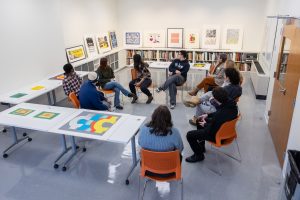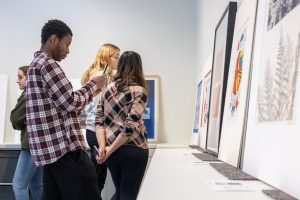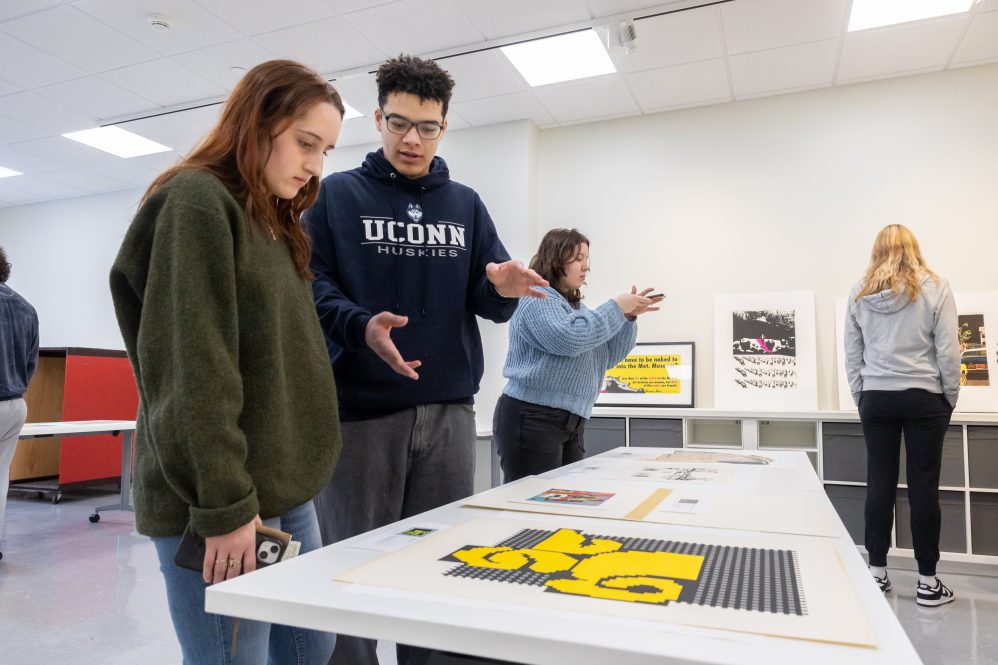Before 11 local Boy Scouts got their hands dirty mixing paint to create their own works of art, William Benton Museum of Art curator of education Mollie Sixsmith shared as inspiration a pair of landscapes by two American painters.
She talked about the elements of art – think, lines and shapes, colors and textures – in Irving Katzenstein’s “The Lake” and Frank Vincent Dumond’s “Spring Willows.” She asked how the two works are different in mood and style and wondered whether the artists would depict each scene differently on another day.
On task to earn their Art merit badges, the Scouts from Tolland considered what they learned, then dove into their own projects, creativity sparked and imaginations wild.
It was a sight Sixsmith and all the staff at the Benton had longed for – the smell of paint in the air, youngsters hunched over pictures of glaciers and volcanoes, voices discussing technique and whether the fire at their last campout looked the same on paper.
This was the group to christen the museum’s new educational space with hands-on artmaking.
After so long, the room off the East Gallery now has a public purpose with fresh white walls, sturdy floors to withstand childhood creativity, and a couple dozen chairs in the Benton’s signature orange.
“Teachers and parents like to have a hands-on component in museum programs,” Sixsmith, curator of education for K-12 and community groups, says. “You take what you learn in the gallery space and apply it in the creation of something hands on. Before we had this space, we’d have to go outside or grab a corner somewhere else in the museum.”

Benton Executive Director Nancy Stula says the room once served as a break room for staff and lately had been relegated mostly to committee meetings. The walls were pink and there was a leather couch that gave it a lounge-type feel.
About a year ago, the School of Fine Arts offered much of the funding necessary for the revamped space and within eight months renovations were complete, Stula says, with the room opening officially at the start of the spring semester.
Amanda Douberley, curator and academic liaison, says she also has used the space in her work with undergrad and graduate students at the University.
In late January, she arranged about 30 paintings, prints, and photographs on top of a bookcase that wraps around half the room for a group of grad students and faculty members from UConn’s Women’s Gender and Sexuality Studies to examine. The group is curating an exhibition for the balcony gallery to coincide with WGSS’s 50th anniversary this year.
At the same tables where the Scouts adorn their paintings, adults are seated to analyze the intricate patterns and delicate details of works from the Benton’s collection.
“It was a chance to see these objects up close and go through the process of elimination to decide what fits best in the exhibition,” Douberley says. “To see the works this close is much better than making decisions based on a little photo that’s online. This space is perfect for that with the directional track lighting because you can see small details.”
Over the last 25 years, Douberley explains, museum education has begun to emphasize visitor engagement and participation rather than encourage a passive experience by just listening to a person talk.
Both, of course, offer some level of understanding, but the engagement part allows for more meaningful learning.
“Museum as Classroom: Teaching and Learning with Art,” the East Gallery exhibition co-curated by Douberley and Sixsmith and open until March 8, highlights the ways the Benton’s collection is used to help students understand classroom material.
Take a look at the wall of seven World War I-era posters that Sherry Zane, WGGS interim director and associate professor-in-residence, uses to teach. A personified Statue of Liberty encourages the purchase of liberty bonds, a Red Cross nurse corrals orphans of the war, an angel implores Americans to “Share in the Victory” and purchase war savings stamps.
“The students talk about what they think is happening in these images, the relationship between image and text, and since the course is Gender and War, the students look at pairs of posters and think about the ways they can analyze them through the lens of gender,” Douberley says. “Usually in a group discussion, we’ll bring out more ties with the course material.”
She adds, “We have a growing roster of faculty who put a visit to the Benton on their syllabus, so having the education center is very helpful. Until now, I’ve been hauling tables out of the closet and setting them up in the gallery where there’s lots of distractions.”
During the fall semester, more than 1,100 students in 68 classes across a dozen departments came through the museum for guided and self-guided visits, Douberley says, a number that’s expected to grow with the new dedicated space and a growing collection of more than 7,000 objects.
And the range of departments is varied from the expected Department of Art & Art History to the perhaps unexpected German, French, landscape architecture, and history departments.
Stula says an engineering professor who teaches fluid dynamics is working with staff now on an upcoming exhibition.
This means, the critical looking wall that Douberley designed for the exhibition, showcasing the inquiry-based learning the Benton promotes and featuring Connecticut artist Earl Kenneth Bates’ painting “Experience,” could very well be used by an earth science class, for instance.
“Begin by describing what you see. What is the first thing you notice,” one thought-balloon writing prompt posted next to the painting asks. “Instead of showing a geranium framed by a window, we see the plant from outside looking in. Why do you think the artist chose this vantage point,” says another.
“We don’t provide the stereotypical idea of just a walk and talk,” Douberley says of what the museum offers. “Instead, we’re really asking visitors to participate, so we can layer back in information. This fall dozens of First Year Experience instructors brought their classes to the museum for a critical looking workshop, in which students sharpen observation skills, practice empathy, and foster critical thinking by examining a single work of art.”

Whether young students studying patterns on a set of four pillars painted by Liz Whitney Quisgard – which are on display in the exhibition along with two of her paintings – or older students looking at a pair of Nigerian masks, also on display, in their development of a stop-motion art project, the Benton’s offerings are for all academic disciplines.
“I love hearing the students’ reactions to a piece of art,” Sixsmith says. “I like to hear about what they’re seeing, what makes them say that, how they feel about the artwork, and how it relates to their life. That all contributes to making the museum a place they feel welcome and comfortable.”
Douberley says she learns from the students almost every day, even though she has a Ph.D. in art history.
“That might seem counterintuitive,” she says, “but the kinds of questions people ask, the connections they make often spark a new thought for me. Museum education and working with university audiences is why I became an art historian.”
Along with University and Scout visits, the Benton also hosts homeschool students, K-12 field trips, a four-week Summer Art Academy for young children, a First Thursday program for UConn students, and online exhibitions.
“When I first started here, I was surprised to learn just how many UConn freshmen had never been to a museum – any museum,” Stula says. “That’s why it’s so important to introduce them to the museum and make them feel like it’s their space and it’s a place for them.”



